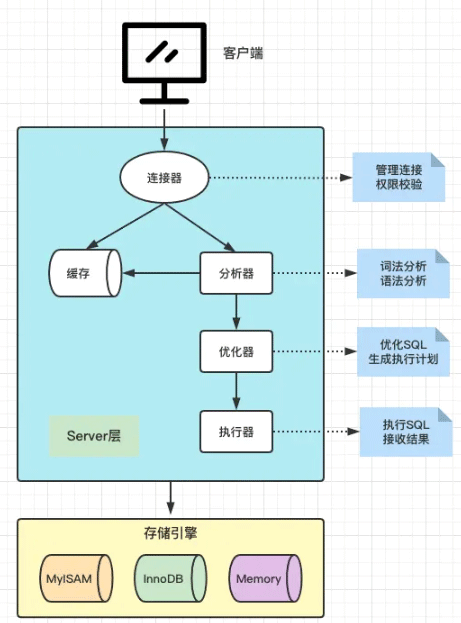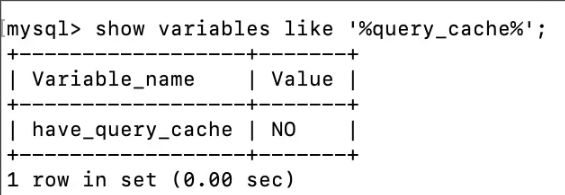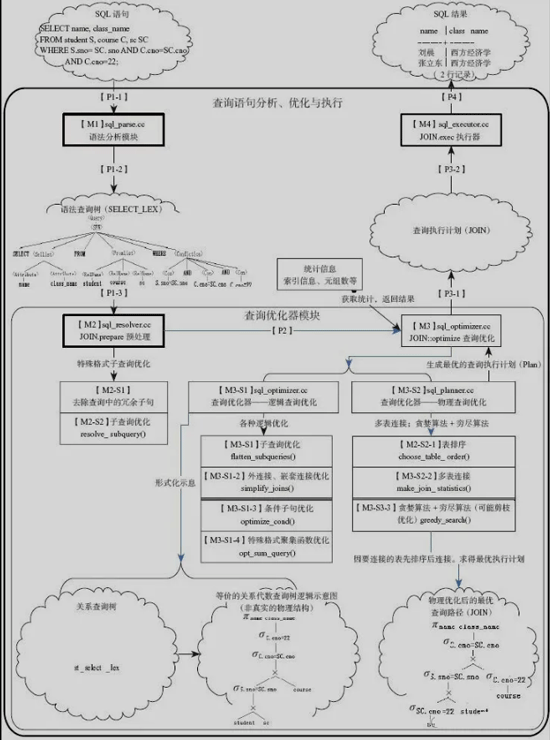MySQL architecture design example analysis
1. MySQL overall architecture
As you can see from the figure, the MySQL architecture is mainly divided into Server layer and Storage engine layer.
Server layer is divided into connectors, caches, analyzers, optimizers, and executors. All cross-storage engine functions are implemented in this layer, such as functions, stored procedures, triggers, views, etc.
Storage engine is pluggable. Common storage engines include MyISAM, InnoDB, Memory, etc. The default was MyISAM before MySQL5.5, and the default after that was InnoDB.

2. Connector
Connector is mainly used to manage client connections and user authentication.
TCP protocol is used for client-server connections. The connection is established by performing a TCP handshake, and based on this, the connector begins authentication.
> mysql -hlocalhost -P3306 -uroot -p
If authentication fails, an error will occur ERROR 1045 (28000): Access denied for user 'root'@'localhost' (using password: YES).
You can view the information of all connections in the system through the show processlist command:

The Commond column represents the connection status, and the Daemon represents the background process , Query represents query, and Sleep represents idle connection.
3. Query cache
The query requested by the client will not directly access the storage engine, but first check whether the result exists in the cache. If the result has been cached, return it directly; otherwise, re-execute the query process and cache the result after the query is completed.
The invalidation cache will be cleared when the data table changes, such as insert, update, delete, and alter operations.
For frequently changing data tables, the cache hit rate is very low. Because using cache will reduce read and write performance, the cache module was removed in versions after MySQL 8.0.
You can check whether the cache is enabled by running the following command:

4. Analyzer
The analyzer is mainly Perform lexical analysis and grammatical analysis on SQL statements.
For MySQL keywords and the meaning of each word, lexical analysis is required. Then perform syntax analysis to detect whether the SQL statement meets the MySQL syntax requirements.
MySQL identifies the column name, table name, where, select/update/insert and other MySQL keywords in the string, and determines whether the sql satisfies the grammar according to the grammar rules, and finally generates an abstract syntax tree (AST) .
For example: If you omit the where keyword in the SQL statement, an error will be prompted.
mysql> select * from user id=1; ERROR 1064 (42000): You have an error in your SQL syntax; check the manual that corresponds to your MySQL server version for the right syntax to use near '=1' at line 1
5. Optimizer
Before the SQL statement is actually executed, it needs to be processed by the optimizer.
The execution plan (Explain) we know well is generated by the optimizer.
The optimizer mainly has two functions: Logical optimization and Physical optimization.
Logical optimization mainly performs equivalent predicate rewriting, conditional simplification, subquery elimination, connection elimination, semantic optimization, group merging, selection pushdown, index optimization query, table query replacement view query, Union replacement or Operation etc.
Through the greedy algorithm and cost estimation model, the main purpose of physical optimization is to estimate the cost of each execution method. And use indexes to optimize table connections and finally generate query execution plans.
Attached is the MySQL optimizer architecture diagram, you can clearly see the optimization process:

6. Executor
After the optimizer optimizes the SQL and generates the execution plan, it will pass the execution plan to the executor.
The executor calls the storage engine interface to actually execute the SQL query. The execution of the SQL statement ends after obtaining the query results returned by the storage engine and returning them to the client.
The above is the detailed content of MySQL architecture design example analysis. For more information, please follow other related articles on the PHP Chinese website!

Hot AI Tools

Undresser.AI Undress
AI-powered app for creating realistic nude photos

AI Clothes Remover
Online AI tool for removing clothes from photos.

Undress AI Tool
Undress images for free

Clothoff.io
AI clothes remover

Video Face Swap
Swap faces in any video effortlessly with our completely free AI face swap tool!

Hot Article

Hot Tools

Notepad++7.3.1
Easy-to-use and free code editor

SublimeText3 Chinese version
Chinese version, very easy to use

Zend Studio 13.0.1
Powerful PHP integrated development environment

Dreamweaver CS6
Visual web development tools

SublimeText3 Mac version
God-level code editing software (SublimeText3)

Hot Topics
 1664
1664
 14
14
 1423
1423
 52
52
 1321
1321
 25
25
 1269
1269
 29
29
 1249
1249
 24
24
 Laravel Introduction Example
Apr 18, 2025 pm 12:45 PM
Laravel Introduction Example
Apr 18, 2025 pm 12:45 PM
Laravel is a PHP framework for easy building of web applications. It provides a range of powerful features including: Installation: Install the Laravel CLI globally with Composer and create applications in the project directory. Routing: Define the relationship between the URL and the handler in routes/web.php. View: Create a view in resources/views to render the application's interface. Database Integration: Provides out-of-the-box integration with databases such as MySQL and uses migration to create and modify tables. Model and Controller: The model represents the database entity and the controller processes HTTP requests.
 MySQL and phpMyAdmin: Core Features and Functions
Apr 22, 2025 am 12:12 AM
MySQL and phpMyAdmin: Core Features and Functions
Apr 22, 2025 am 12:12 AM
MySQL and phpMyAdmin are powerful database management tools. 1) MySQL is used to create databases and tables, and to execute DML and SQL queries. 2) phpMyAdmin provides an intuitive interface for database management, table structure management, data operations and user permission management.
 MySQL vs. Other Programming Languages: A Comparison
Apr 19, 2025 am 12:22 AM
MySQL vs. Other Programming Languages: A Comparison
Apr 19, 2025 am 12:22 AM
Compared with other programming languages, MySQL is mainly used to store and manage data, while other languages such as Python, Java, and C are used for logical processing and application development. MySQL is known for its high performance, scalability and cross-platform support, suitable for data management needs, while other languages have advantages in their respective fields such as data analytics, enterprise applications, and system programming.
 Solve database connection problem: a practical case of using minii/db library
Apr 18, 2025 am 07:09 AM
Solve database connection problem: a practical case of using minii/db library
Apr 18, 2025 am 07:09 AM
I encountered a tricky problem when developing a small application: the need to quickly integrate a lightweight database operation library. After trying multiple libraries, I found that they either have too much functionality or are not very compatible. Eventually, I found minii/db, a simplified version based on Yii2 that solved my problem perfectly.
 Laravel framework installation method
Apr 18, 2025 pm 12:54 PM
Laravel framework installation method
Apr 18, 2025 pm 12:54 PM
Article summary: This article provides detailed step-by-step instructions to guide readers on how to easily install the Laravel framework. Laravel is a powerful PHP framework that speeds up the development process of web applications. This tutorial covers the installation process from system requirements to configuring databases and setting up routing. By following these steps, readers can quickly and efficiently lay a solid foundation for their Laravel project.
 Solve MySQL mode problem: The experience of using the TheliaMySQLModesChecker module
Apr 18, 2025 am 08:42 AM
Solve MySQL mode problem: The experience of using the TheliaMySQLModesChecker module
Apr 18, 2025 am 08:42 AM
When developing an e-commerce website using Thelia, I encountered a tricky problem: MySQL mode is not set properly, causing some features to not function properly. After some exploration, I found a module called TheliaMySQLModesChecker, which is able to automatically fix the MySQL pattern required by Thelia, completely solving my troubles.
 MySQL: Structured Data and Relational Databases
Apr 18, 2025 am 12:22 AM
MySQL: Structured Data and Relational Databases
Apr 18, 2025 am 12:22 AM
MySQL efficiently manages structured data through table structure and SQL query, and implements inter-table relationships through foreign keys. 1. Define the data format and type when creating a table. 2. Use foreign keys to establish relationships between tables. 3. Improve performance through indexing and query optimization. 4. Regularly backup and monitor databases to ensure data security and performance optimization.
 MySQL: Key Features and Capabilities Explained
Apr 18, 2025 am 12:17 AM
MySQL: Key Features and Capabilities Explained
Apr 18, 2025 am 12:17 AM
MySQL is an open source relational database management system that is widely used in Web development. Its key features include: 1. Supports multiple storage engines, such as InnoDB and MyISAM, suitable for different scenarios; 2. Provides master-slave replication functions to facilitate load balancing and data backup; 3. Improve query efficiency through query optimization and index use.




